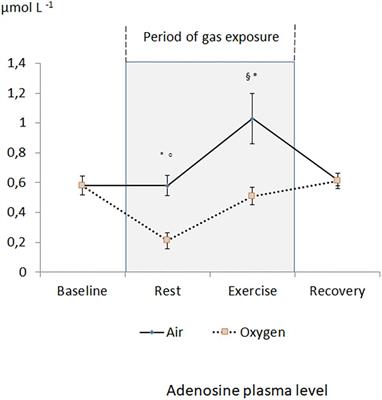
Adenosine is an ATP derivative that is strongly implicated in the cardiovascular adaptive response to exercise. In this study, we hypothesized that during exercise the hyperemia, commonly observed during exercise in air, was counteracted by the downregulation of the adenosinergic pathway during hyperoxic exposure.
Methods
Ten healthy volunteers performed two randomized sessions including gas exposure (Medical air or Oxygen) at rest and during exercise performed at 40% of maximal intensity, according to the individual fitness of the volunteers. Investigations included the measurement of adenosine plasma level (APL) and the recording of hemodynamic data [i.e., cardiac output (CO) and systemic vascular resistances (SVR) using pulsed Doppler and echocardiography].
Results
Hyperoxia significantly decreased APL (from 0.58 ± 0.06 to 0.21 ± 0.05 μmol L–1, p < 0.001) heart rate and CO and increased SVR in healthy volunteers at rest. During exercise, an increase in APL was recorded in the two sessions when compared with measurements at rest (+0.4 ± 0.4 vs. +0.3 ± 0.2 μmol L–1 for medical air and oxygen exposures, respectively). APL was lower during the exercise performed under hyperoxia when compared with medical air exposure (0.5 ± 0.06 vs. 1.03 ± 0.2 μmol L–1, respectively p < 0.001). This result could contribute to the hemodynamic differences between the two conditions, such as the increase in SVR and the decrease in both heart rate and CO when exercises were performed during oxygen exposure as compared to medical air.
Conclusion
Hyperoxia decreased APLs in healthy volunteers at rest but did not eliminate the increase in APL and the decrease in SVR during low intensity exercise.

Δεν υπάρχουν σχόλια:
Δημοσίευση σχολίου